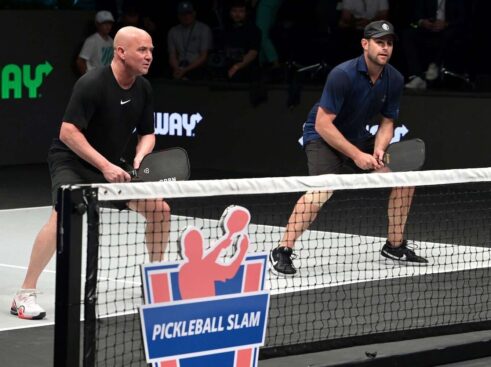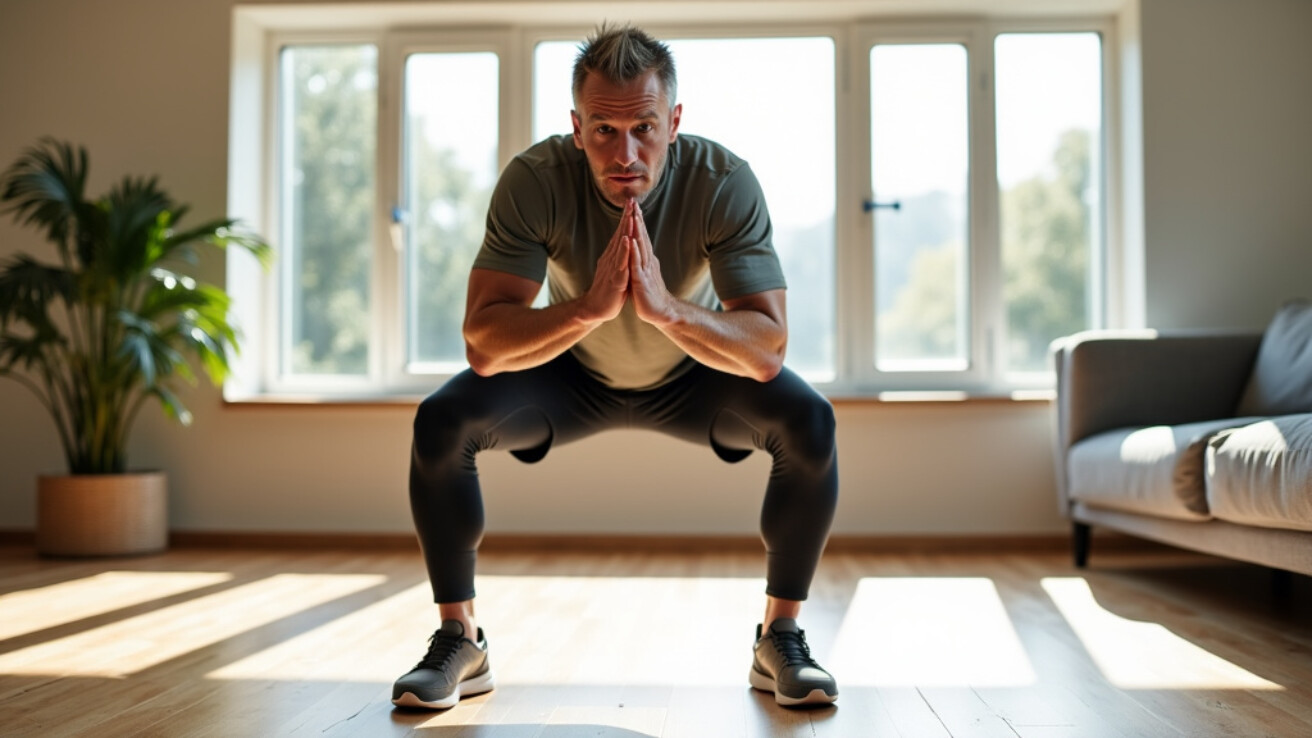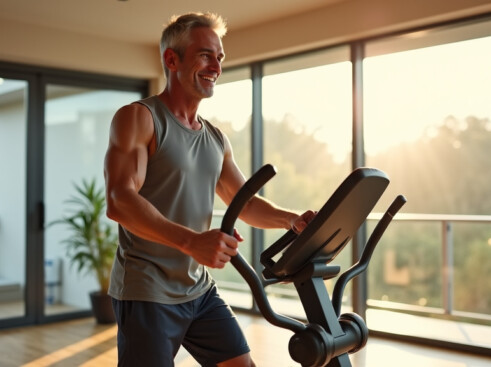Tired of expensive gym memberships and complicated fitness equipment? The solution for an effective cardio workout is simpler than you might think – and it’s right in your living room.
According to the American College of Sports Medicine, men should aim for 150-300 minutes of moderate physical activity weekly for optimal cardiovascular health. This goal is entirely achievable without setting foot in a gym.
The beauty of equipment-free cardio workouts lies in their effectiveness and convenience. These exercises use your body weight to burn calories, improve heart health, and build endurance – all while saving you time and money.
Whether you’re a busy professional, a dad juggling family responsibilities, or simply prefer working out at home, this guide will show you how to transform any space into your personal cardio zone. No fancy machines required – just your determination and a few square feet of floor space.
Ready to learn how simple bodyweight exercises can deliver an effective, heart-pumping workout? Let’s explore exercises that will enhance your home fitness routine and help you achieve your health goals without any equipment investment.
Benefits of Home Cardio Workouts for Men
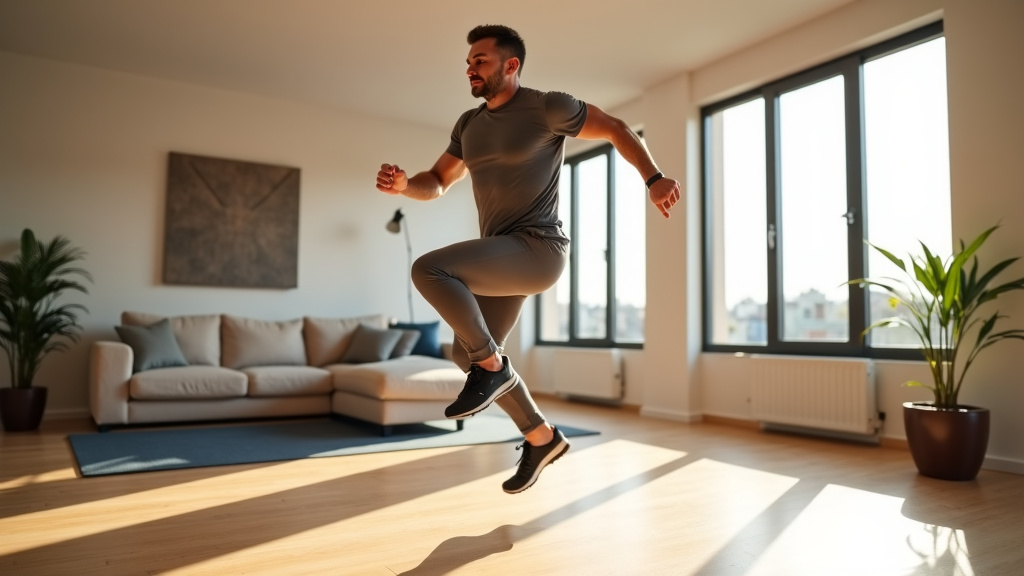
Imagine achieving your fitness goals without leaving your living room. That’s the power of home cardio workouts for men – a convenient, effective approach to staying fit that resonates with busy professionals and fitness enthusiasts alike.
According to the Cleveland Clinic, cardio exercise is essential for maintaining heart health and can significantly improve your quality of life. Regular cardiovascular activity decreases blood pressure and resting heart rate while improving cholesterol levels.
Time and Cost Efficiency
Gone are the days of lengthy commutes to crowded gyms and expensive membership fees. Home cardio workouts eliminate these hassles, allowing you to maximize your time and save money.
Whether you’re squeezing in a quick session before work or unwinding after a long day, having your workout space just steps away means more time exercising rather than preparing to exercise.
The financial benefits are compelling. With no recurring membership fees or expensive equipment required, you can invest in a few basic items like resistance bands or a jump rope and still achieve excellent results.
Enhanced Privacy and Comfort
Working out at home provides a judgment-free environment where you can focus entirely on your fitness journey. No more feeling self-conscious about your form or competing for equipment with others.
This private setting allows you to experiment with different exercises and intensities without the pressure of onlookers. You can push your limits or take it easy depending on how you feel that day.
The comfort of familiar surroundings helps reduce workout anxiety, making it easier to establish and maintain a consistent exercise routine.
Cardiovascular Health Benefits
Home cardio workouts deliver the same heart-healthy benefits as gym-based routines. Regular cardiovascular exercise strengthens your heart muscle and improves its efficiency in pumping blood throughout your body.
These workouts help reduce the risk of heart disease, stroke, and high blood pressure – conditions that particularly affect men. The key is maintaining consistency with your chosen exercises.
Even moderate-intensity activities like brisk walking or stationary cycling can significantly improve heart health when done regularly.
Metabolism and Weight Management
A consistent home cardio routine boosts your metabolism, helping you burn calories more efficiently throughout the day. This increased metabolic rate continues even after your workout ends.
Weight management becomes more achievable when you combine regular cardio with proper nutrition. The convenience of home workouts makes it easier to maintain consistent exercise habits.
Research shows that men who engage in regular cardio exercise maintain healthy weight and body composition more effectively.
| Exercise | Calories Burned (125 lbs) | Calories Burned (155 lbs) | Calories Burned (185 lbs) |
|---|---|---|---|
| Running | 652 | 808 | 965 |
| Jumping Jacks | 8 to 11.8 per minute | ||
| Jump Rope | 453 | 562 | 671 |
| Mountain Climbers | 7 to 12 per minute | ||
| Burpees | 10 to 15 per minute | ||
| Swimming | 198 to 294 in 30 minutes | ||
| Stationary Bicycling | 420 | 520 | 622 |
High-Intensity Interval Training (HIIT) Cardio Routines
HIIT cardio workouts have transformed modern fitness training, providing an efficient method to enhance cardiovascular endurance and maximize calorie burn. These dynamic workouts alternate between intense 30-second to 2-minute bursts of maximum effort and strategic recovery periods.
According to research from the Fit Father Project, HIIT workouts can be customized for any fitness level while delivering impressive results for men of all ages. Their effectiveness stems from adaptability and time efficiency.
The Science Behind HIIT’s Effectiveness
During intense intervals, you’re not just burning calories in the moment. Your metabolism remains elevated for up to 24 hours afterward, producing what fitness experts call the afterburn effect.
Norwegian research suggests performing HIIT at 85-95% of your maximum heart rate during work intervals, followed by active recovery at 60%. This approach optimizes both fat burning and cardiovascular improvements.
These intense bursts challenge your heart and lungs more effectively than steady-state cardio, leading to improved VO2 max – your body’s ability to utilize oxygen during exercise.
Essential HIIT Exercises for Maximum Results
Burpees excel as one of the most effective full-body HIIT movements. They engage multiple muscle groups simultaneously while significantly elevating your heart rate.
Mountain climbers provide another powerful option, combining core strengthening with cardiovascular benefits. The rapid alternating leg movement maintains elevated heart rate while targeting your abs and shoulders.
Jumping jacks, while fundamental, prove remarkably effective for HIIT routines. They quickly elevate your heart rate while improving coordination and engaging your entire body.
Creating Your HIIT Workout Structure
Begin with a proper warm-up of light jogging or dynamic stretches for 5 minutes. This preparation is essential for the intensity ahead.
Structure your main workout with 30 seconds of all-out effort followed by 15 seconds of active recovery. This work-to-rest ratio optimizes calorie burn while preventing excessive fatigue.
Complete 4-6 rounds of each exercise before progressing to the next one. Remember, proper form takes precedence over speed – maintain control throughout intense intervals.
Low-Impact Cardio Options for Beginners and Joint Health

Starting a fitness journey doesn’t have to mean punishing your joints with high-impact exercises. In fact, low-impact cardio activities can be just as effective while being gentler on your body.
Whether you’re managing joint sensitivity or prefer moderate movement, these workouts provide impressive cardiovascular benefits without the harsh impact of traditional exercises. Let’s explore effective options that will strengthen your heart safely.
Swimming and Water-Based Activities
The pool provides an ideal environment for beginners to build cardiovascular fitness. The water’s natural buoyancy supports your joints while providing resistance for a full-body workout.
Water aerobics classes are especially beneficial, combining social interaction with structured exercise. Instructors provide modifications to ensure each movement suits your fitness level and comfort.
Even basic pool walking or gentle swimming laps can significantly improve your cardiovascular health while protecting your joints. The water’s warmth helps reduce stiffness and discomfort.
Walking and Elliptical Training
Walking remains one of the most accessible forms of low-impact cardio. Begin with short distances and gradually increase your pace and duration as your fitness improves.
The elliptical machine provides a joint-friendly alternative to running. It mimics natural walking movements while keeping your feet in constant contact with the pedals, eliminating impact shock.
Start with 10-15 minutes on the elliptical and gradually increase your time. The adjustable resistance settings allow you to customize the intensity to match your fitness level.
| Exercise | Calories Burned (155 lbs) | Calories Burned (185 lbs) | Joint Impact |
|---|---|---|---|
| Walking (4 mph) | 175 | 189 | Low |
| Swimming | 216 | 252 | Low |
| Stationary Biking | 252 | 294 | Low |
| Rowing | 252 | 292 | Low |
| Skating | 386 | 461 | Low |
Indoor Cycling and Rowing
Stationary bikes offer an excellent cardiovascular workout without stressing your joints. The smooth, circular pedaling motion builds leg strength while being gentle on your knees.
Rowing provides an efficient full-body cardio option. It engages multiple muscle groups simultaneously while maintaining minimal impact, making it ideal for beginners seeking comprehensive workout benefits.
Remember to focus on proper form and start with lighter resistance. Your body will adapt gradually, allowing you to increase intensity while maintaining joint health.
Bodyweight Cardio Exercises for Strength and Endurance
Transform your living room into a fitness sanctuary with effective bodyweight cardio exercises that deliver impressive results without equipment. These dynamic movements combine cardiovascular training benefits with muscle-strengthening resistance work.
Research shows these exercises can be just as effective as traditional gym workouts for building strength and endurance. According to a study highlighted by StrengthLog, bodyweight exercises like push-ups can match the muscle-building benefits of bench pressing, especially for beginners.
Foundation Exercises for Maximum Impact
Mountain climbers serve as a cornerstone movement, engaging your core while elevating your heart rate. Maintain a straight back and alternate bringing each knee toward your chest with controlled, deliberate movements.
Burpees provide exceptional full-body conditioning. This comprehensive exercise combines a push-up, plank, and jump, effectively building both muscular endurance and cardiovascular capacity.
Bodyweight squats target the largest muscles in your body, burning significant calories while strengthening your legs and core. Maintain proper form by keeping your chest up and knees aligned with your toes.
Advanced Variations for Greater Challenge
After mastering basic movements, incorporate plyometric variations like jump squats and explosive push-ups. These power moves increase caloric burn while improving fast-twitch muscle fiber recruitment.
High-knee sprints in place maintain an elevated heart rate between strength movements. Drive your knees up toward your chest while pumping your arms for maximum effectiveness.
Plank-to-knee tap combinations enhance stability while maintaining cardiovascular intensity. Control your weight transfer as you alternate touching each knee.
Creating an Effective Workout Structure
Structure your workout in intervals, performing each exercise for 30-60 seconds followed by brief 15-second rest periods. This method optimizes both strength gains and endurance improvements.
Alternate between upper and lower body movements to maintain intensity while allowing muscle groups to recover. This approach prevents early fatigue and maintains proper form.
Listen to your body and adjust the intensity as needed. Though equipment-free, these exercises provide significant challenge when performed with proper form and intensity.
Creating an Effective Home Cardio Workout Plan
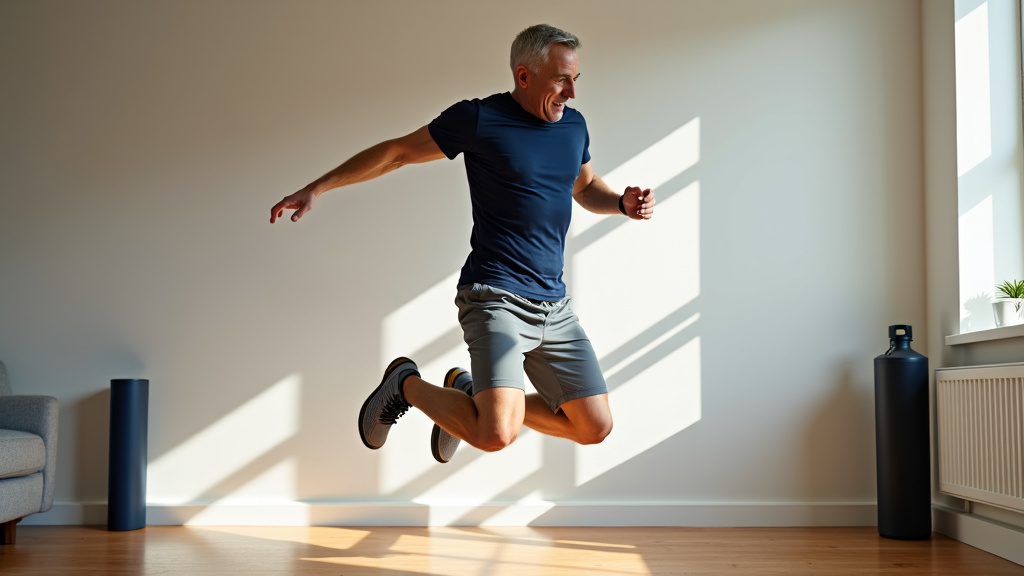
Developing a sustainable home cardio routine requires thoughtful planning and realistic goal-setting. The American College of Sports Medicine recommends 150-300 minutes of moderate physical activity weekly for optimal health benefits.
Your fitness journey begins with understanding your current capabilities and setting achievable targets. Whether you’re a complete beginner or returning to exercise, start with basic movements like marching in place, jumping jacks, and modified mountain climbers.
Progressive overload – gradually increasing workout intensity – forms the cornerstone of any effective cardio plan. Begin with 10-15 minute sessions at a moderate pace, then systematically increase duration and intensity as your fitness improves.
Structuring Your Weekly Routine
Balance high-intensity interval training (HIIT) with lower-impact steady-state cardio across 3-5 weekly sessions. This approach optimizes both calorie burn and cardiovascular endurance while allowing adequate recovery between workouts.
On HIIT days, alternate between 30-60 seconds of intense exercises like burpees or squat jumps with equal rest periods. Keep your Rate of Perceived Exertion (RPE) between 7-8 out of 10 during work intervals.
For steady-state sessions, maintain a moderate intensity (RPE 5-6) with exercises like jogging in place or dance cardio. These workouts should feel challenging but allow you to hold a conversation.
Essential Components for Success
Proper warm-up and cool-down periods protect against injury and enhance performance. Spend 5-10 minutes doing dynamic stretches and light cardio before increasing intensity.
Listen to your body’s signals and adjust workout intensity accordingly. Some muscle soreness is normal, but sharp pain indicates a need to modify or rest. Schedule rest days between challenging sessions to allow proper recovery.
Track your progress using simple metrics like workout duration, exercise variations completed, or perceived effort levels. Celebrating small wins maintains motivation and helps identify areas for improvement.
Adapting Your Plan
Customize your workout schedule based on your lifestyle and energy levels. Morning people might prefer starting their day with cardio, while others may find evening sessions more sustainable.
Don’t hesitate to modify exercises to match your fitness level. For instance, perform mountain climbers against a wall instead of the floor, or march in place rather than doing jumping jacks if high-impact moves feel too challenging.
Remember that consistency trumps perfection. It’s better to complete three moderate workouts weekly than burn out trying to maintain an unsustainable schedule.
Maximizing Results: Tips for Effective Home Cardio Sessions
Transforming your living room into a high-performance cardio zone doesn’t require fancy equipment or endless hours. The secret lies in how you approach and execute your workouts. Here are proven strategies to maximize your home cardio results.
Perfect Your Form First
Proper form isn’t just about preventing injuries – it’s the foundation of an effective workout. When performing exercises like burpees or mountain climbers, focus on controlled movements rather than rushing through repetitions.
According to fitness experts at Peloton, mastering proper form before increasing intensity is essential for preventing injury and maximizing results. Your body needs time to adapt to new movement patterns.
Pay special attention to your breathing rhythm and core engagement during exercises. Proper form ensures you’re targeting the right muscle groups and optimizing every movement.
Build Consistent Habits
Consistency trumps intensity for achieving real results from your cardio workouts. Schedule your sessions like important meetings – mark them in your calendar and treat them as non-negotiable commitments.
Find your optimal workout time, whether it’s early morning before work or during your lunch break. Creating a dedicated workout space helps maintain focus, especially when exercising at home.
Track your progress to stay motivated. Record improvements in your endurance, recovery time, and overall energy levels to maintain momentum.
Progressive Intensity Building
Gradually increasing workout intensity prevents plateaus and keeps your body adapting. Start with manageable intervals – perhaps 30 seconds of work followed by 30 seconds of rest.
As your fitness improves, adjust your work-to-rest ratios. You might progress to 40 seconds of work with 20 seconds of rest, challenging your cardiovascular system in new ways.
Listen to your body while pushing boundaries. Focus on steady progress rather than immediate perfection.
Mix Up Your Routine
Variety isn’t just about preventing boredom – it’s essential for continuous improvement. Alternate between different cardio styles like HIIT, steady-state training, and circuit workouts.
Include exercises that target different movement patterns. Combine jumping jacks with mountain climbers, burpees with high knees to create engaging sequences that challenge your body in new ways.
Remember to incorporate recovery days to prevent burnout and allow your body to adapt to the training stimulus.
The Benefits of Home Cardio Workout
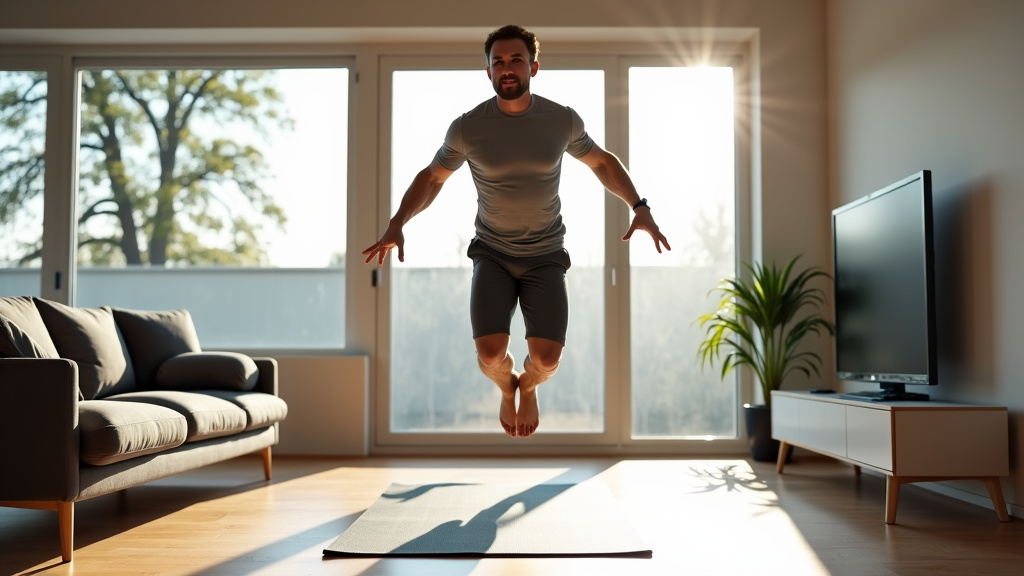
The science is clear: home cardio workouts deliver remarkable benefits for cardiovascular health and overall wellbeing. According to research by the American Heart Association, even short bursts of cardio exercise significantly improve heart health and reduce disease risk.
Exercising at home eliminates common barriers such as gym memberships, commute time, and scheduling constraints. With minimal space and equipment, you can engage in effective workouts that burn calories, build endurance, and strengthen your cardiovascular system.
Home cardio routines provide exceptional flexibility – you can choose from exercises like jumping jacks, mountain climbers, and burpees to keep workouts fresh and challenging. These varied movements prevent plateaus while targeting different muscle groups for comprehensive fitness improvements.
The convenience of home cardio makes it easier to maintain consistency, which research shows is crucial for long-term health benefits. Whether you have 10 minutes or an hour, you can elevate your heart rate and work toward your fitness goals from the comfort of home.
Home cardio workouts serve as an effective tool for improving your health. By incorporating these exercises into your regular routine, you’re investing in stronger cardiovascular fitness, better weight management, and enhanced overall wellbeing – all without leaving your house.


